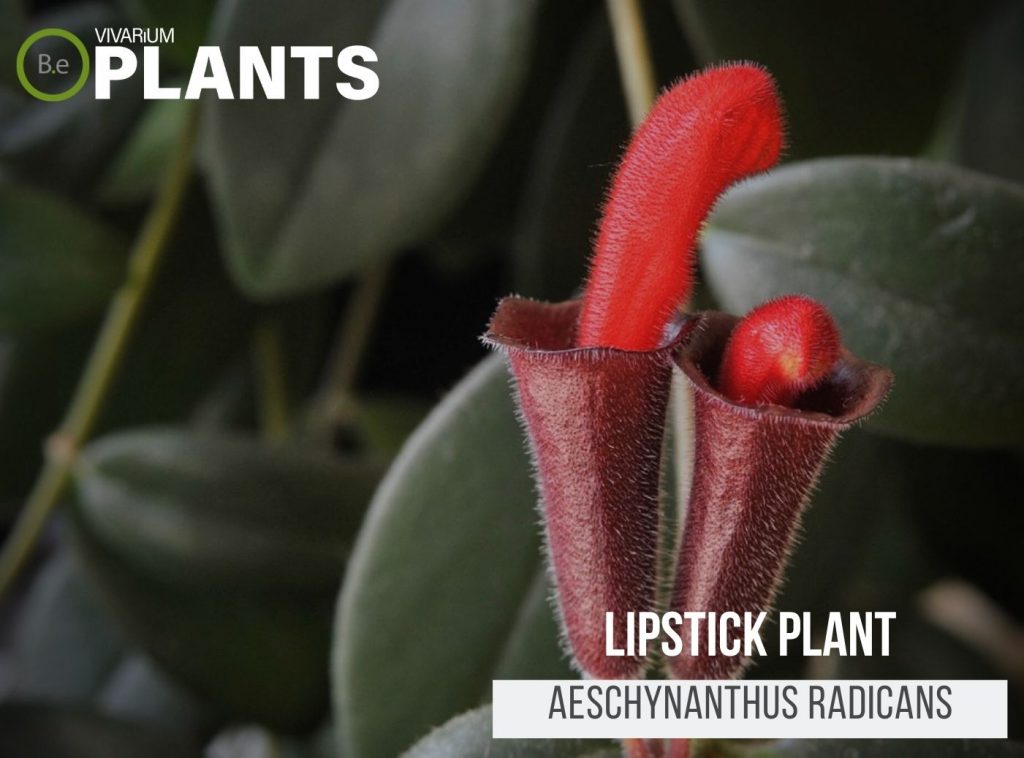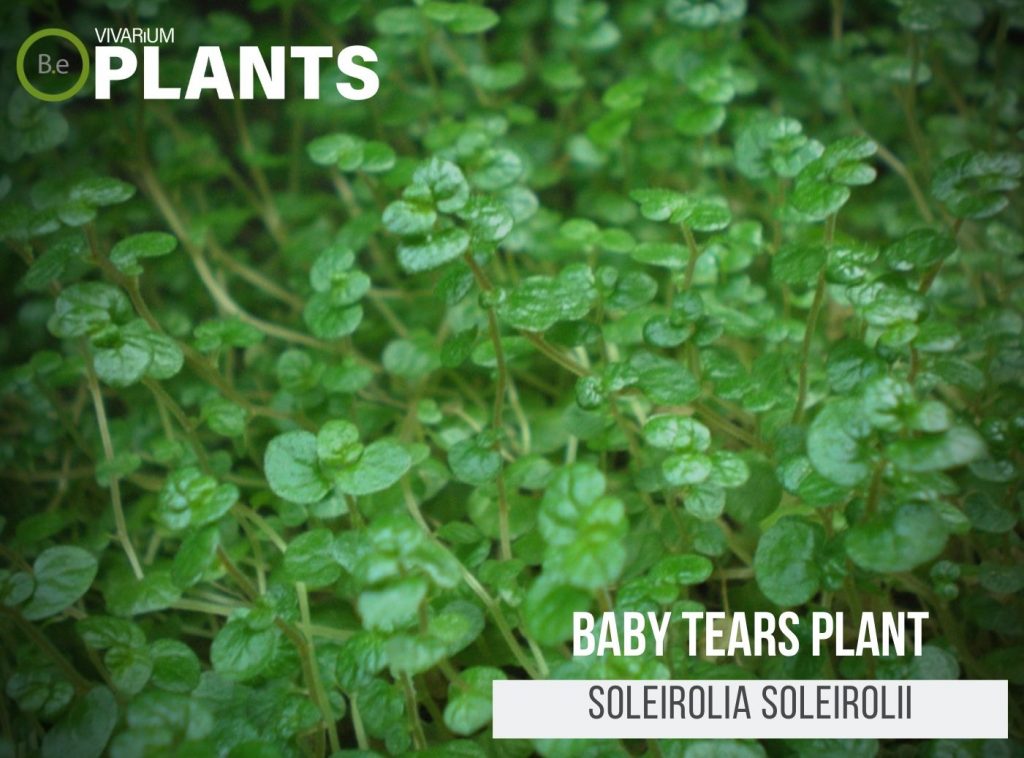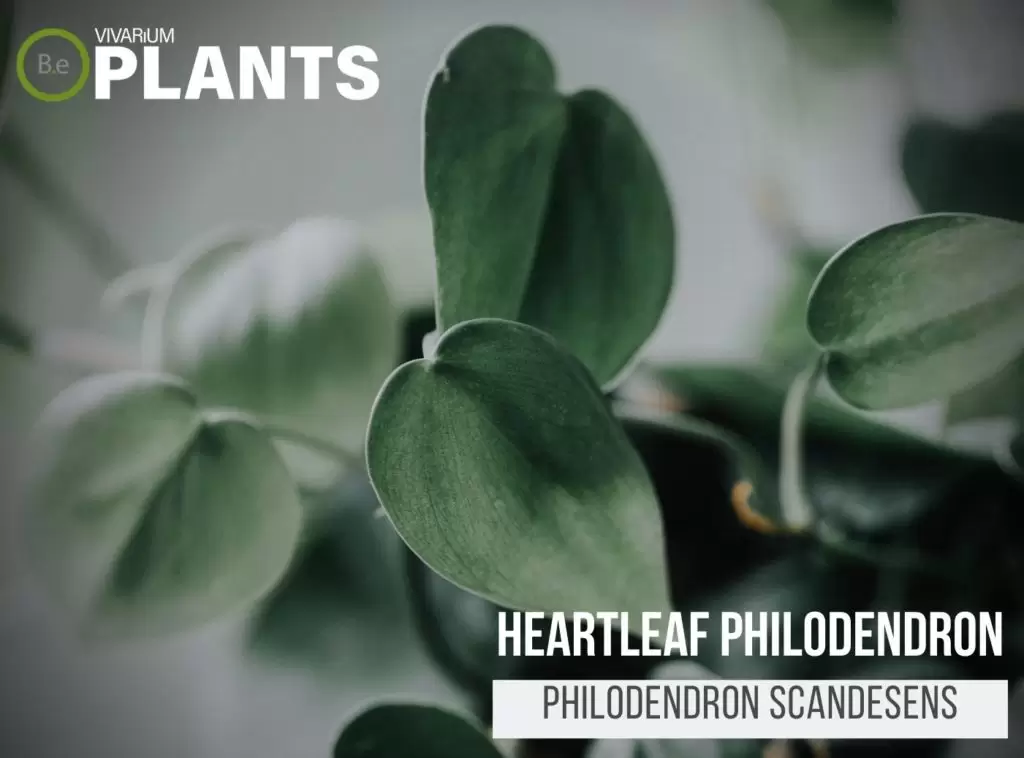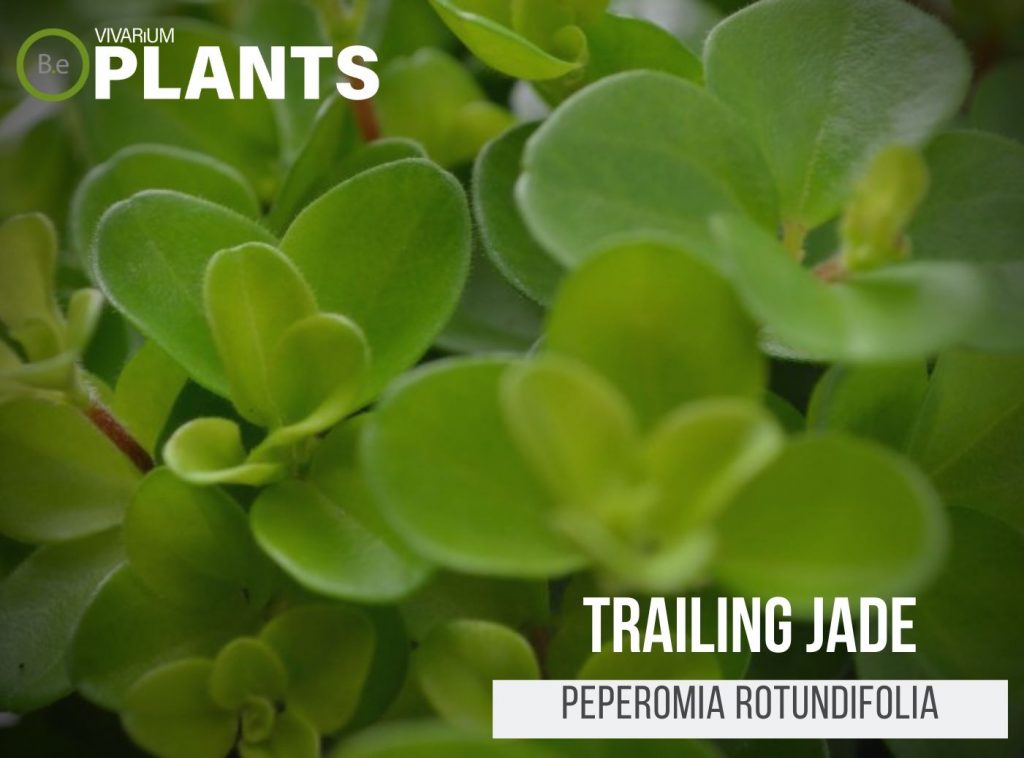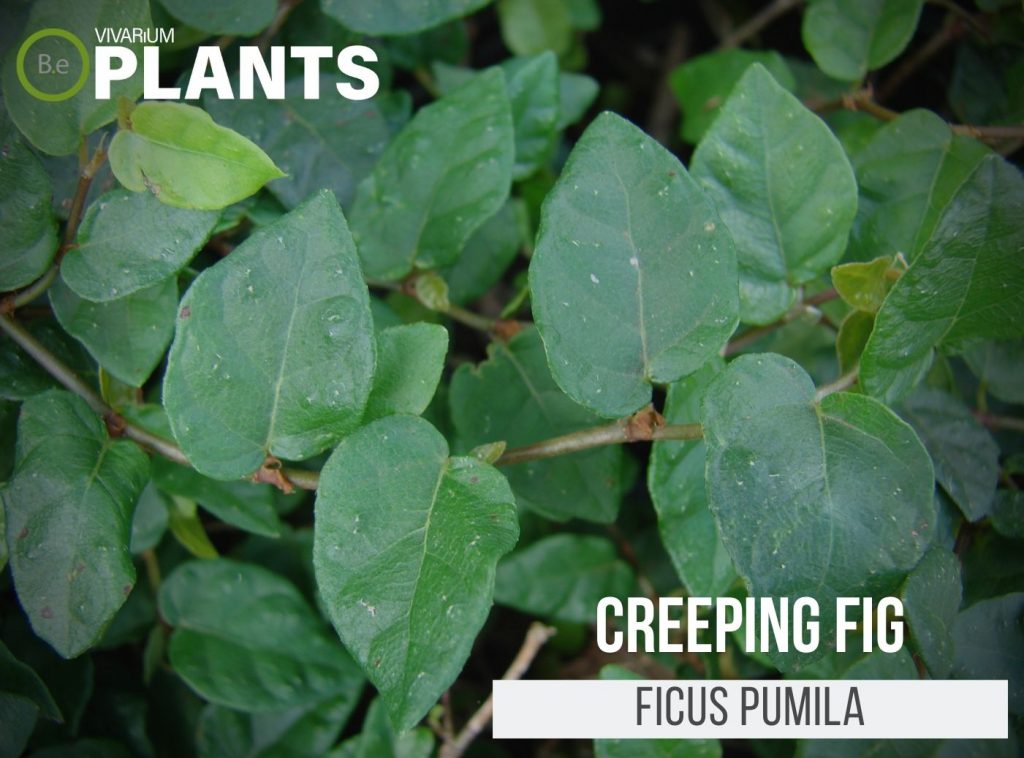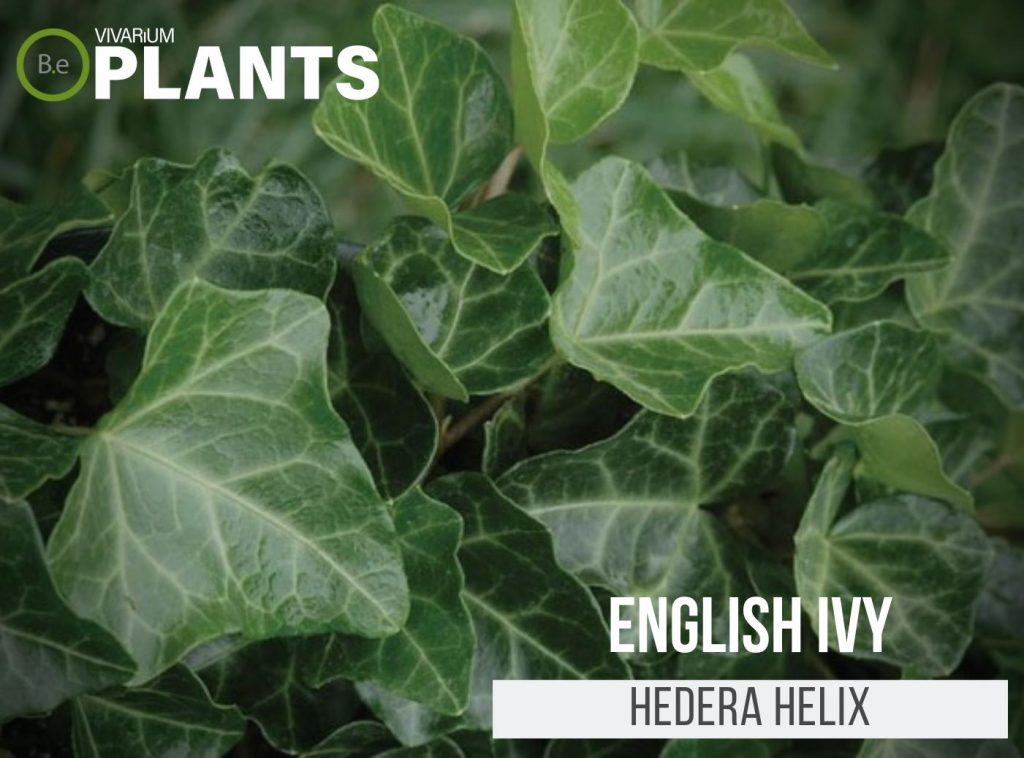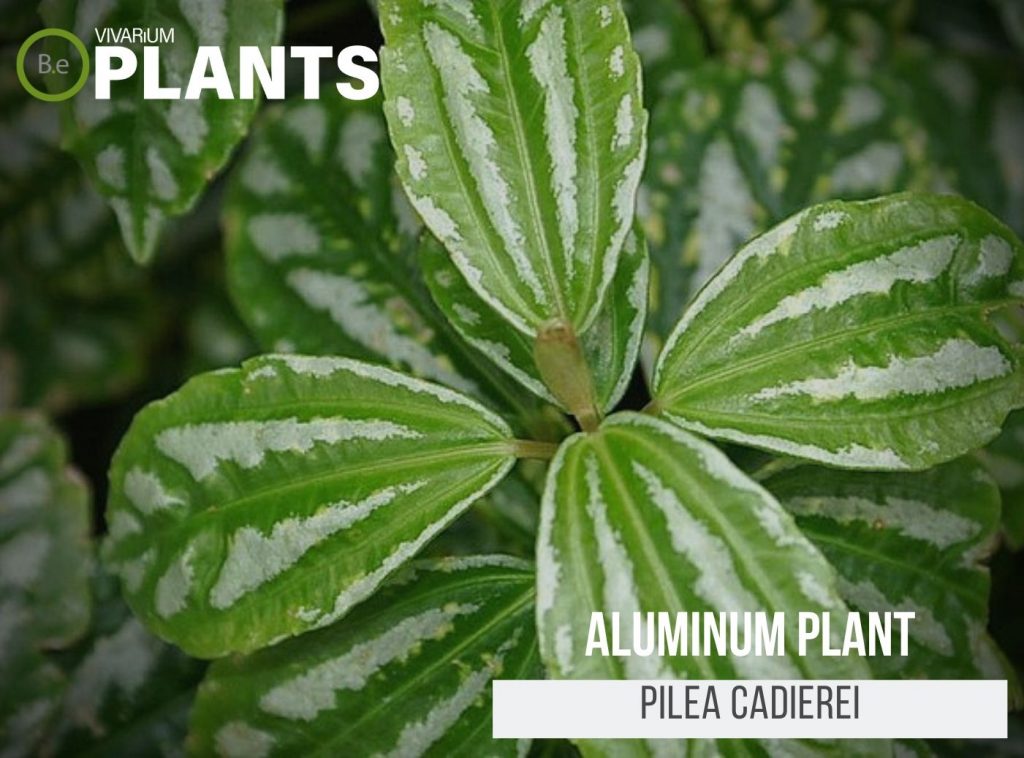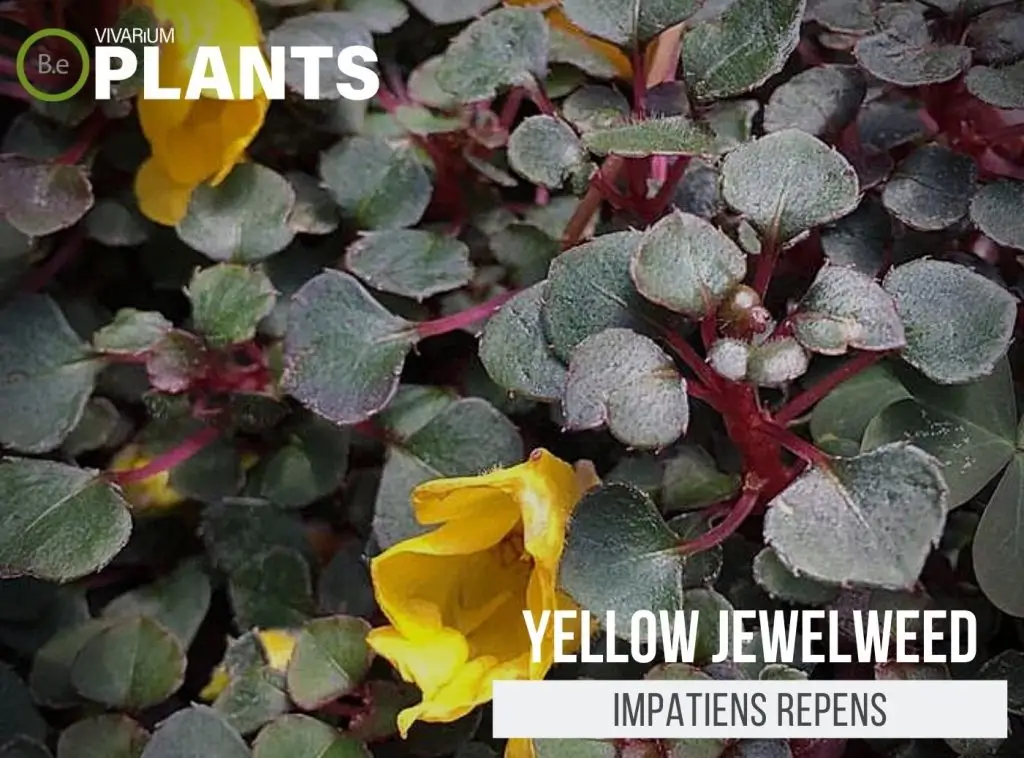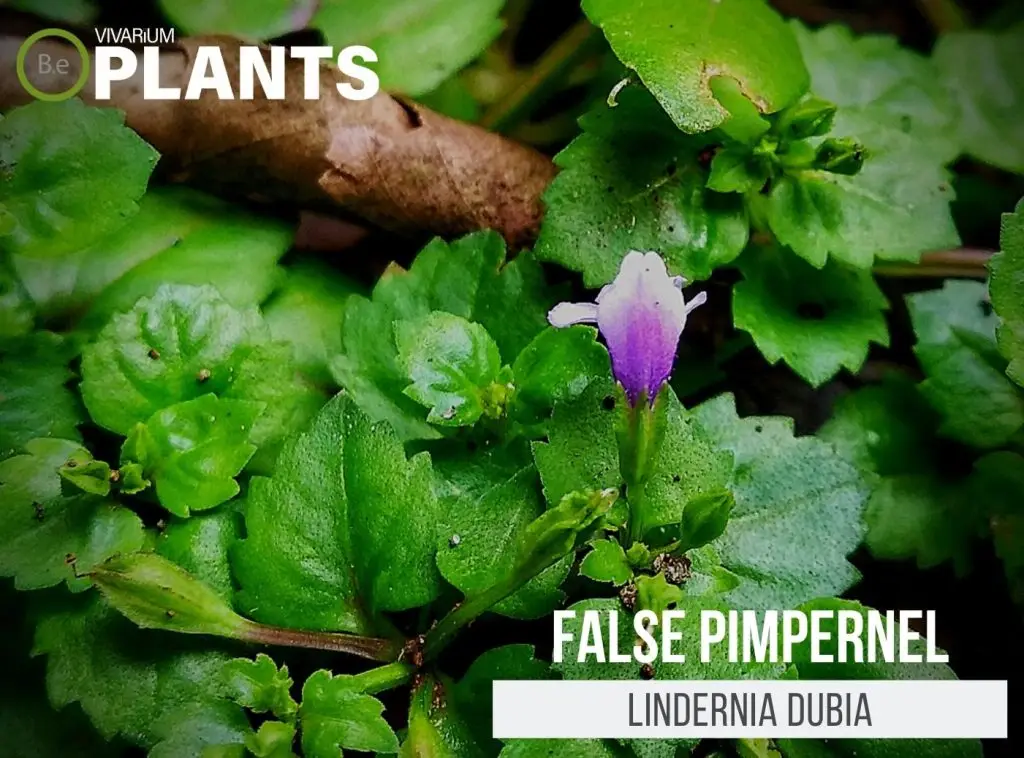Vine plants are a really good type of flora to consider in a vivarium.
These plants are one of the few that offer the possibility to scape vertically.
They are very suitable for an environment that needs a background cover due to their growth pattern.
They will cascade downward when planted high in an enclosure or climb upward towards the light when planted on the bottom.
Vining plants will even grow horizontally making them ideal for a good ground cover.
This article will provide an in-depth guide to everything you would want to know about these types of vivarium plants as well as provide a complete list to choose from.
Table Of Contents:
ToggleWhat Are Vine Plants?
Vine plants, also commonly referred to as climbers or vines, are plants that grow in a trailing pattern along a particular surface.
These plants can grow in any direction as long as they have suitable support to anchor to.
Vines may resemble a similar pattern to carpeting plants in the way they spread.
The difference between the two is that vine typically spread above ground and has a more perennial stem structure.


Climbing & Trailing Plants
Vine plants have a number of evolutionary ways that allow them to be such amazing climbers.
Depending on the particular species and environment, these plants will find a way to get the resources they depend on to survive.
Today we will offer a complete list of vine plants ideal for life within a vivarium.
Before we jump into the list, I would like to cover a few key aspects of these types of vivarium plants.
Not only will you better understand climbers… You will make the right decisions on picking plants perfect for your particular setup.
These types of plants come in a number of varieties and will have unique care requirements depending on the species.
Some vine plants exhibit vining habits all the time while others will use their climbing capabilities when the habitat presents the opportunity for the plant to climb or trail.
For the most part, botanists will divide these plants into two groups… Bines and Vines.
Vine plants that utilize the bine technique typically use their stems to anchor onto an object for support.
They generally have a more sturdy stem structure and many will even resemble wood-like qualities.
Some plants in this group even have tiny bristles that point downward to assist with grip and stability.
The second group of plants is considered vines.
These vine plants have evolved in a way that allows them to grow specialized stems that will latch onto objects allowing the main stem to remain free to roam.
These can include thorns, tendrils, and adhesive pads.
We will go more into depth with different types of ways vining plants use these tools in the next section.
Ways Vine Plants Climb
Climbing plants can be further broken down into five specific categories based on the habit in which they use to anchor to nearby objects.
Some plants may use more than one specialized form to latch on surfaces.
Understanding the particular way a species of vine plant trails will help assure the longevity of the plant in care as well as inhabitants that share the enclosure.
Feel free to use this section as a reference when deciding on which vivarium plant within this list to consider for a tank.
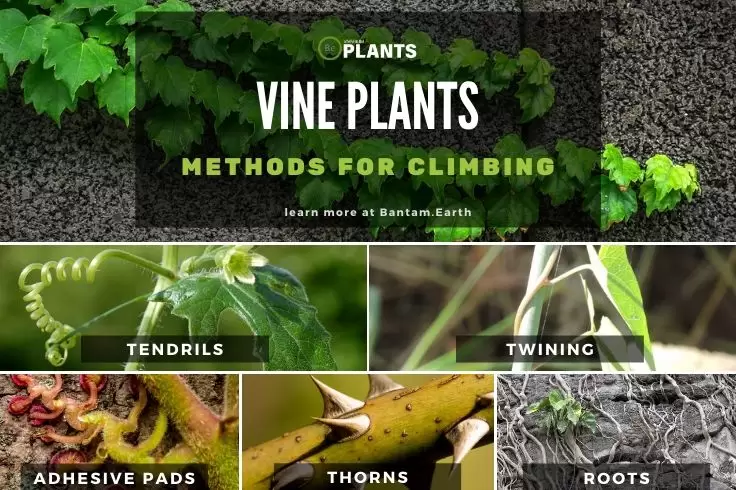

Tendrils
Tendrils are small curly threads that sprout from the stems of some vine plants.
These appendages are like arms to the plant that reaches out and twines around nearby objects.
They are sensitive to touch and in many cases will spiral around suitable surfaces the moment the tendril comes in contact with that entity.
Narrow objects placed within the enclosure like sticks or other vines are the most ideal subjects to use because they are small enough for tendrils to wrap around.
Twining
Besides tendrils, on some species of vines, stems themselves are capable of twining around objects for support.
This is technically what the first group “bines” do when they climb.
Some species will even use their leaves in the place of their stems to twine around surfaces.
Larger objects like rocks or driftwood can be used as suitable objects to latch on to with these types of vines.
Adhesive Pads
Few vine plants possess the unique ability to grow adhesive pads along their stems or tendrils.
This gives the plants an opportunity to find support on wider surfaces that are too big to physically wrap around.
The sticky counterparts make it easy for the plants to climb vertically as well as crawl horizontally.
One precaution to take with vivariums housing inhabitants along with these types of vines is that some species may produce an adhesive that is toxic when digested.
Thorns
Thorns are another way many vine plants will find support when climbing vertically.
This allows the plant to easily cling to many types of surfaces as well as its own stems placed firmly within an enclosure.
Flowering plants usually come to mind when many think of vines that produce thorns.
Use caution with these plants as well as around inhabitants as they can present easy opportunities for injuries.
Roots
Vines are unique in the way they form roots. Some are able to sprout roots along the stem of the plant at the same rate as the sprout leaves.
This allows the plant to further absorb nutrients from places other than the plant’s base root system.
Roots can work in a similar fashion to tendrils, only they are thicker and don’t possess full twining capabilities.
Nonetheless, they still have the ability to cling to surfaces or penetrate weak surfaces allowing the vine plants to easily support themselves as they climb or trail.
Types Of Vine Plants
Now that there is a general understanding of various kinds of vines and bines, we can cover the best types of vine plants for controlled environments.
The ideal types of climbing plants can do well in a number of biotypes.
It just depends on the specific type of plant it is and its individual care requirements.
With that in mind, a hobbyist has a vast amount of options when it comes to stocking an enclosure with vine plants.
Terrarium Vine Plant Types
Terrarium vines are the terrestrial version of the climbing plant that thrives on land away from flowing water.
For the most part, vine plants like moist, humid environments but not overly saturated soils.
Moderate airflow, as well as proper drainage, will be a necessity for terrarium-dependent vines.
Upper areas of paludariums will also be great environments for these kinds of plants.
Below is a complete list of vivarium vines to consider:
String Of Pearls (Curio rowleyanus)
Curio rowleyanus, formally known as Senecio Rowleyanus, is a unique type of succulent that has vine plant qualities.
Commonly referred to as String Of Pearls, this plant exhibits pea-shaped leaves that trail along the stem.
Curio is mostly recognized as a household plant but can do very well in a terrarium due to its hardy nature.
Like many succulents, this plant has the ability to retain water making it tolerable to longer periods of drought than most other types of plants.
This is a great vine to consider in vivariums that are low humidity and mostly dry.
The type of habitat String Of Pearls is commonly found in is mountainous and arid biotypes.
This makes the vivarium plant ideal for desert-themed terrariums being built for reptiles.
Curio doesn’t climb like other vines but rather cascades downward.
When using this plant place it high within the vivarium around bright lights and allow it to drape down over cliff edges.
If opting to use this plant on lower levels of the enclosure, it will creep vertically creating a nice carpeting effect along the ground area.
Wandering Jew (Tradescantia zebrina)
Tradescantia zebrina is colorful, vibrant, and relatively easy to maintain.
This vine plant, commonly referred to as a Wandering Jew, is suitable for tropical vivariums.
The bright green and white stripe patterns on the leaves radiate with various shades of purple depending on the amount of light the plant receives.
Wandering Jew will climb in all directions making it a great vivarium plant to consider for the background as well as foreground use.
Zebrina don’t have toxic appendages making them safe for use around terrestrial pets.
Subtropical to fully tropical environments are what make up the habitat this vine does best in so keep it in mind when constructing.
This is a shade-happy plant so avoid direct sunlight and provide brightly lit surroundings.
Wandering Jew, for the most part, is a very hardy plant I would recommend to beginner-level enthusiasts.
Lipstick Plant (Aeschynanthus radicans)
Aeschynanthus radicans are a vine plant that will produce flowers resembling lipstick.
It has glossy, dark green leaves that are either oval-shaped or twisted depending on the species.
Even though flowering plants have proven to be quite difficult to bloom within vivariums to many hobbyists, with the right setup it is possible.
Nonetheless, the Lipstick Plant is still a gorgeous plant to use with or without its unique flowering.
This plant will also grow in all directions but is mostly left to cascade downward when used as a household plant.
The care requirements for Lipstick Plants are going to be similar to other tropical vines.
It can be grown epiphytically on backgrounds or buried in loose acidic soil. Even though this plant produces flowers…
It can still be sensitive to long periods of direct sun exposure and should be kept in shade the majority of the time.
Furthermore, avoid placing Aeschynanthus Radicans too close to aquatic areas as well.
This is a terrain base vine that requires a moist, humid environment.
Baby Tears (Soleirolia soleirolii)
Soleirolia soleirolii is a perfect carpeting plant for terrariums.
Also known as Baby Tears, it closely resembles the aquatic carpeting plant many beginner hobbyists refer to as Dwarf Baby Tears.
This fast-growing vine can span in all directions and keeps a rather shallow depth of thickness as it spreads outward.
Even though it does require a bit of upkeeping, Baby Tears is a relatively easy vine plant to care for.
Making it great for beginners looking for an easy vivarium plant to consider.
The habitat to which Baby Tears Plant is native is warm, humid, and boggy.
This is an ideal setting for paludariums provide naturally due to the aquatic portions within the tank.
Be generous with watering while carefully assuring a well-drained substrate.
This is a great plant for beginners that understand the basics of good water parameters and lighting.
Radiator Plant (Peperomia Spp.)
Radiator Plants are commonly referred to as a variety of plants within the Peperomia genus.
These plants are small, compact, and exhibit some type of unique foliage.
This terrestrial vine is ideal for use anywhere there are open pockets in the vivarium that need filling.
Peperomia plants are excellent climbers and will spread a dense mat in all directions.
Many of the miniature species of Peperomia have a strong resemblance to succulents but are in fact not related to the drought-tolerant plants in any way.
Radiator Plants are mostly native to tropical areas of Brazil.
Even though these plants are one of the most common household plants on this list, they are very suitable for the atmosphere tropical terrariums provide.
The caretaking needs of Peperomia Plants are relatively minimal.
Just provide plenty of bright lighting, acidic water, and a well-drained substrate.
Many Radiator Plants are also epiphytes, meaning they can root to many driftwoods, rocks, and other types of hardscapes.
Satin Pothos (Scindapsus pictus ‘argyraeu’)
Scindapsus pictus ‘argyraeu’ is one of the slower-growing vine plants on this list.
Commonly referred to as Satin Pothos amongst many other names, this climber can be grown epiphytically on bark as well as various types of soils.
The silver spots sprinkled over its dark green leaves make this plant stand out in a nice subtle way that isn’t overpowering in enclosures that are dominant in one or two colors.
Satin Pothos are tropical and more tolerant of aquatic areas than other vines on this list.
When considering a suitable environment for the Scindapsus pictus ‘argyraeu’, tropical or subtropical biotypes are the most ideal settings for this plant.
Paludariums with plenty of room for height will give this plant all the room it needs to spread out.
Trimming will be needed if you only want to use this plant in small amounts.
Satin Pothos uses a root-type climbing system to latch onto surfaces.
This makes it easy for the plant to obtain necessary nutrients wherever it can within the enclosure.
Heartleaf Philodendron (Philodendron scandesens)
Philodendron scandesens are one of many species of Philodendron covered in this list.
And for good reason, they do extremely well in vivariums.
This variation of the genus is commonly known as Heartleaf Philodendron due to its appearance.
This vine is an actual flowering plant but since most vivariums will have controlled light, the chances of seeing blossoms in a tank are low.
Nonetheless, this plant is still a very visually pleasing flora to have in a terrarium.
Its care requirements are minimal, just make sure it receives a good amount of lighting and is well-hydrated with slightly acidic water.
The habitat Heartleaf Philodendron thrives in should be tropical, mimicking a rainforest biotype.
Keep it in a well-drained substrate away from standing water to avoid root rot.
Keep the terrarium relatively warm and the humidity high to have a healthy and happy Philodendron.
Philodendron Brasil (Philodendron hederaceum)
Philodendron hederaceum is another variation of the Philodendron genus.
In the vivarium niche, this species is arguably the more popular of the two.
Commonly known as Philodendron Brasil, the foliage has a similar heart shape with the exception of being a bit more narrow.
It also typically has two-tone leaves often exhibiting a light shade of green on one-half of most leaves.
One of my favorite things about stocking Philodendrons in an enclosure is its ability to absorb toxins and purify air and water.
This can prove extremely beneficial over a period of time for tanks that house pets.
The care requirements for Philodendron Brasil will be the same as over plants of the same genus.
It’s a tropical thriving flora that will not do well in direct water or desert biotypes.
Use water with PH levels between 5 and 6.
Be mindful not to oversaturate soils.
If you’re using this vine as an epiphyte, keep a consistent level of high humidity so that roots don’t dry out.
Trailing Jade (Peperomia rotundifolia)
Peperomia rotundifolia is another variation of the Radiator Plant with its own set of characteristics.
Commonly referred to as Trailing Jade, this vine has more of a rope look to it as it grows.
It has bright evergreen leaves that are small and oval-shaped.
As a household plant, it is very common practice to use it as an epiphyte and hang it in a basket allowing it to cascade down.
This same method can be used in a vivarium setting placing it high in the enclosure.
It can grow as tall as six inches before the weight of the stems pulls it downward.
Trailing Jade will require a tropical-type of environment where temperatures range between 65 to 85 degrees.
High humidity and moderate amounts of water would be highly recommended.
Avoid placing this plant in contact with direct water and it should do well on its own.
Polka Dot Plant (Hypoestes phyllostachya)
Hypoestes phyllostachya is a flowering plant with very colorful leaves. They come in an assortment of variations.
Commonly referred to as the Polka Dot Plant, the various colors always exhibit some sort of spotted pattern.
This vine uses a twining method to anchor to surfaces and climb or trail its way toward needed resources.
Polka Dot Plant can also be used as an epiphyte meaning it will not require soil in order to survive.
Humidity levels will need to be elevated to accommodate for the exposure of the roots to air.
The Polka Dot Plant is native to the tropical parts of South Africa, East Asia, and Madagascar.
This makes the vine plant suitable for lower temperatures but it will thrive in warmer climates.
The care maintenance required to keep this plant healthy is minimal.
Use well-drained soils and latch them directly to driftwood. When watering, use moderately acidic water.
Creeping Fig (Ficus pumila)
Ficus pumila is a shrub-like vine plant that can stack up in height relatively quickly.
This plant has many common names due to being so popular for its easy caretaking.
Some of these include Climbing Fig, Creeping Fig, & Fig Ivy, Just to name a few.
The dark green, arrow-shaped leaves sprouted along the stem can give any vivarium a seasoned look as well as allow easy cover for tiny inhabitants.
This vine is one of the best climbers on this list and will spread in any direction it can trail out to.
Regular trimming may be required frequently to keep this aggressive grower in check.
Being native to East Asia, Creeping Fig is most suitable for subtropical biotypes.
Terrariums with well-drained substrates, bright lighting, and high humidity will be the best setting for this vine plant.
English Ivy (Hedera helix)
Another very popular climbing plant within households is the Hedera helix.
This vine plant, frequently called English Ivy or Common Ivy, has arrow-shaped leaves that are slightly larger than creeping figs.
Helix has dark green foliage with a lighter shade of green veins coursing throughout the surface.
It has excellent climbing capabilities and will spread over everything it comes in contact with.
English Ivy can make a fitting carpet plant, background plant, or even an accenting foreground plant if trimmed regularly.
The habitat English Ivy is accustomed to is a woodland biotype.
That makes this vine plant perfect for dry terrariums that don’t have high humidity levels.
Hedera Helix is tolerable to a broad range of PH levels. Substrates should be well-drained but roots can tolerate contact with direct water for a period of time.
This is without a doubt one of the hardest vine plants on this list.
Devil’s Ivy (Epipremnum aureum)
Epipremnum aureum is undoubtedly one of the hardiest vine plants on this list.
For that very reason, it is probably the most popular household plant as well.
It is the true definition of a vine using roots as well as twining to anchor onto nearby objects.
It has oval-shaped leaves that are bright green and will exhibit streaks of white throughout the surface depending on the amount of light it receives.
Common names for this plant include Devil’s Ivy, Golden Pothos, and Silver Vine.
When it comes to caring requirements for Golden Pothos, it is a very forgiving vine.
It can tolerate just about any level of light, though bright lighting will be the most ideal for vibrant foliage.
It can survive in a number of soils, as an epiphyte, or even partially submerged with leaves above water.
Suitable PH levels for Devil’s Ivy should be slightly acidic. Check out this extensive guide about Microsorum pteropus for care tips and more information about this type of plant.
Asparagus Fern (Asparagus setaceus)
Asparagus Ferns are one of my favorite vine plants on this list.
It may not be the easiest to take care of but once you figure out its needs it is an extremely aesthetic flora to have in terrariums of all scales.
Scientifically known as Asparagus setaceus, this plant is a vine that closely resembles many types of ferns.
It has no other correlation to the fern family other than its name and foliage appearance.
It climbs easily and spreads very quickly often becoming invasive if not kept in check.
The habitat that Asparagus Fern thrives in is moist, humid, and forest-like.
This vine may not be safe for all inhabitants and is better kept in plant-only setups.
Its care requirements are typical of most tropical plants.
Plenty of light, a well-drained substrate, and neutral PH will be the ideal setting for Setaceus to thrive within.
Boggy soils and aquatic areas should be avoided.
Aluminum Plant (Pilea cadierei)
The Pilea genus is a spectacular group of plants to use in vivariums.
There are over 700 known species within the large group of plants.
Many of these vines possess miniature foliage and vary in look.
The particular species we consider ideal for tropical biotypes is the Pilea Cadierei.
Commonly known as the Aluminum Plant or Watermelon Pilea, this vine sports green-colored leaves with strips of silver scattered across the surface.
Cadierei is an actual flowering plant but the chances of blossom are low when using artificial lighting.
The habitat in which Aluminium Plants are native is a tropical rainforest in Southeast Asia.
These vine plants can tolerate direct sunlight for short periods of time and thrive in high humidity.
Suitable vivariums will require a well-drained substrate and consistent watering.
The PH levels of the water should be slightly acidic.
Creeping Jenny (Lysimachia nummularia)
Creeping Jenny is a popular terrarium vine that is known for its low-lying yellow or chartreuse foliage and its contrasting green stems.
The delicate clusters of small, star-shaped flowers are usually yellow or white.
This ivy-like plant is easy to care for and will grow happily in any terrarium, creating a dense mat of foliage with its low-lying stems and roots.
Creeping Jenny has a long-lasting seasonal interest and is sure to bring a bright and cheerful look to any terrarium.
Although Creeping Jenny is not a creeper or a climber, it has the ability to seamlessly merge with other plants to create a lush, unified look.
The pale foliage of the Creeping Jenny complements other terrarium plants, highlighting their beauty while also creating a natural backdrop.
It can also be used as a ground cover to reduce evaporation and create a uniform look in the terrarium.
Trailing Daisy (Sphagneticola trilobata)
The Trailing Daisy is an excellent choice for terrariums due to its low-maintenance and drought-tolerant nature.
Featuring white or yellow daisy-like flowers, the Trailing Daisy makes a great accent plant that adds a nice pop of color to a terrarium.
It is an especially good choice for those who don’t have a green thumb as it is quite easy to care for.
The vine trails are in their second year, making them a great option for terrariums with limited space.
The Trailing Daisy’s profuse flowering habit is one of its defining characteristics.
It is incredibly easy to care for, keeping its blooms for many months without any additional fertilizer.
Trailing Daisy can also add a lovely scent to a terrarium, with its delicate flowers perfuming the air with their sweet and light fragrance.
Yellow Jewelweed (Impatiens repens)
Yellow Jewelweed is a great option for terrariums due to its hardiness and trailing tendencies.
Its leaves are netted in yellow and its flowers can also be yellow or white.
As it grows and spreads it adds a lot of lushness to a terrarium.
This vine is quite adaptable to different environments and can grow in a variety of temperatures, light levels, and humidity.
Jewelweed grows reasonably quickly and can fill in the bottom and sides of any terrarium with its long, trailing branches.
Yellow Jewelweed is tolerant to most common garden pests and will not be damaged by snails or slugs.
It grows best in moist, well-draining soil and prefers to get at least four hours of direct sunlight daily.
It is one of the few tropical plants that can survive space-challenged terrariums, growing into a lush green carpet without taking over the whole terrarium.
False Pimpernel (Lindernia dubia)
False Pimpernel is a popular trailing houseplant and is often used in terrariums.
It has a soft, fine texture, with delicate, wiry stems and small, oval, or heart-shaped leaves.
The flowers are charming and star-shaped and come in color variations of white, lavender, purple, and pink.
Native to India and Southeast Asia, False Pimpernel grows quickly, making it a great addition to any terrarium.
It will spread across the soil, creating a great visual effect and adding a touch of greenery to the environment.
False Pimpernel comes in two varieties – the perennial species and the annual species.
The annual species can be replanted each year and is a great choice for those who want to add seasonal color and cheer to their terrarium.
The perennial species can be grown in permanent potting containers, creating a long-lasting display of beautiful foliage and flowers.
No matter which variety you choose, False Pimpernel is sure to add a stunning and elegant look to any terrarium.
In Summary
When browsing this list of possible vine plants to stock your enclosure with…
Be conscious of the potential plant’s needs and the type of enclosure being built for it.
Understanding a few vital aspects of these trailing plants will make up the difference in having a successfully established tank.


If you are still having trouble trying to figure out which type of climbing plant would be best for your setup…
Feel free to drop a comment below and we will help you get the ball rolling.
Furthermore, If you would like to see a particular type of vine-covered that is not yet on this list, let us know as well!
What is your experience with vine plants… Which kind are your favorite types to have in an enclosure?
Frequently Asked Questions
1. English Ivy
2. Bougainvillea
3. Boston Ivy
4. Honeysuckle
5. Jade Plant
6. Swedish Ivy
7. Grape Ivy
8. Morning Glory
9. Clematis
10. Passion Flower
The most common vine plant is English Ivy (Hedera helix). It is a hardy evergreen perennial that is native to Europe, Asia, and North Africa. English Ivy is a fast–growing vine that can easily grow up to 20 feet, making it ideal for covering walls, fences, and trellises. It‘s fragrant foliage provides not only an attractive ground cover, but also helps reduce noise levels.
The fastest-growing vining plants are both fast-climbing and fast-spreading varieties. Some examples of these include sweet potato plants, morning glories, cucumber plants, and black–eyed Susan vines. All of these can quickly increase their growth rate thanks to the way they climb and spread, often reaching heights of up to twenty feet in just one season.
1. English Ivy
2. Boston Ivy
3. Trumpet Vine
4. Dwarf Morning Glory
5. Sweet Potato Vine
6. Creeping Fig
7. Clematis
8. Climbing Hydrangea
9. Moonflower
10. Hops



